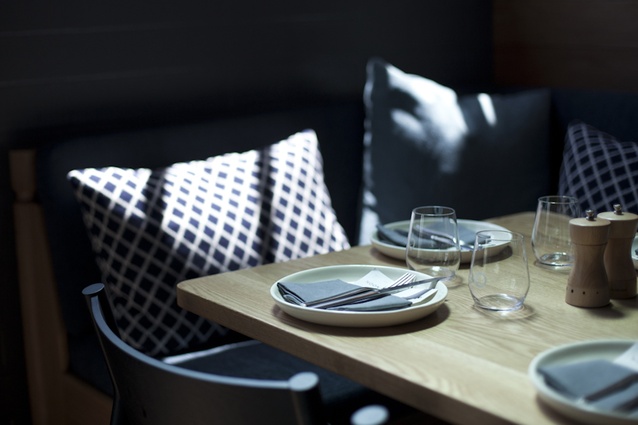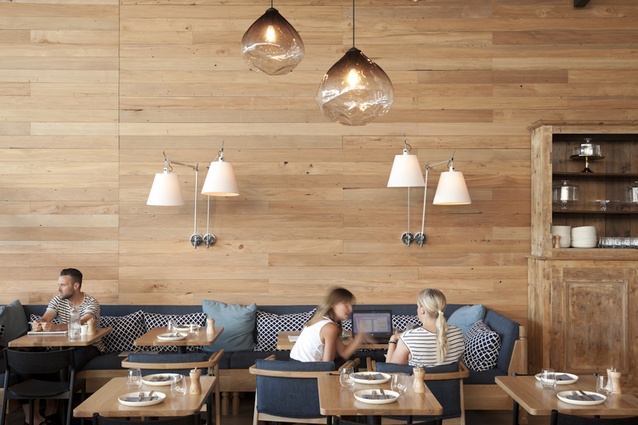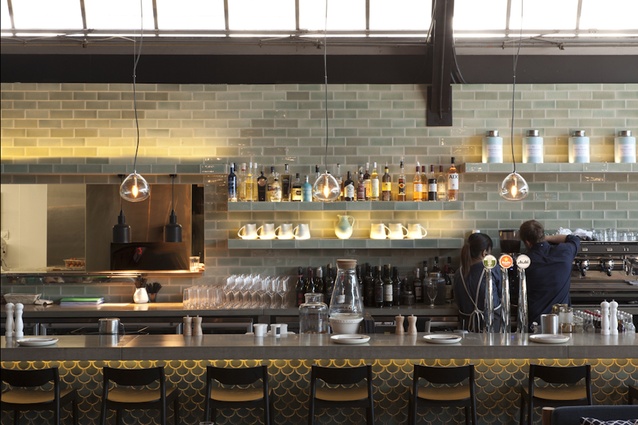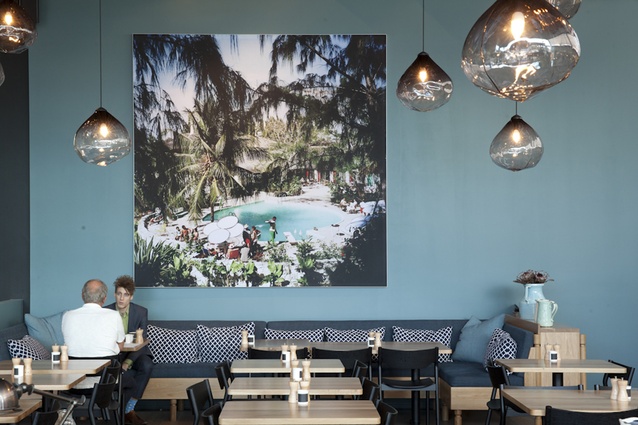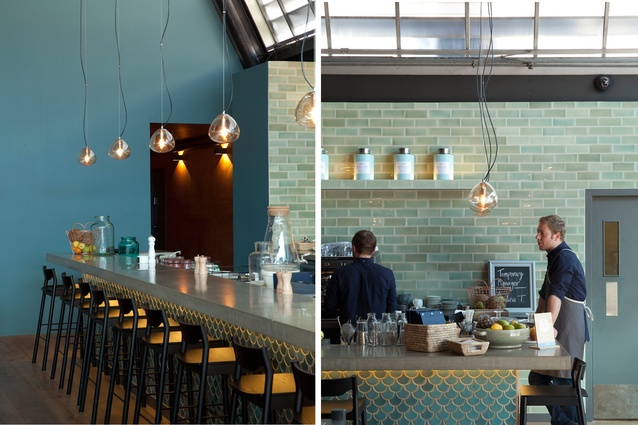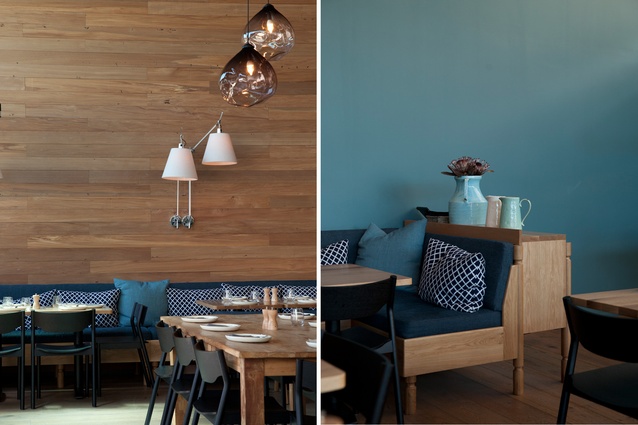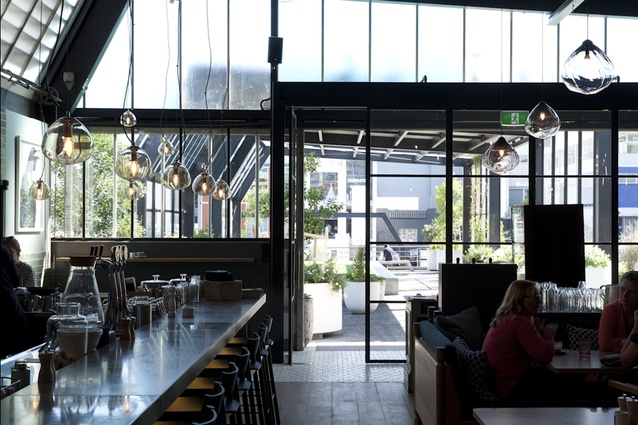Odettes
Auckland restaurateurs Clare and Joost van den Berg – who founded, designed, ran and subsequently sold the popular Herne Bay café Zus & Zo as well as Takapuna’s Zomer Café – see Odettes as the one venue they’ve been working towards. “The other spaces have been stepping stones,” says Clare, adding that her husband and business partner Joost had been looking for a locale like this for close to two-and-a-half years, during which Clare researched, gathered ideas and scrapbooked for the eatery-to-be.
“I wanted the space to feel quite calm,” she says; “I wanted lots of textures. We also wanted it to feel lived in as opposed to too perfect.” She mentions her passion for travel, a past career in the film industry and being surrounded by objects that have significant personal history as key drivers here.
“We had a very strong idea of what we liked to do… which, for an architect, is probably their worst nightmare!” she continues. Nonetheless, the van den Bergs enlisted the help of City Works Depot mastermind Cheshire Architects to act as a sort of casual mentor for Clare. “Basically, I would sit down with Nat [Cheshire] every two to three weeks and be like ‘hey, here are these fabrics or this chair or what do you think of this wool?’ And he would say ‘I like what you are trying to do’ and guide me towards people he had worked with in the past to create what we had in mind. It was a really nice, loose collaboration.”
Bespoke items such as linen cushions, staff uniforms, booths and other detailing were imagined by Clare, drawn (some of the plans polished by Cheshire Architects) and sent to designers and manufacturers. Some off-the-rack pieces such as Simon James’ Tangerine chairs, Robert Gordon ceramics and Nat Cheshire’s Parison Pendant lights share space with vintage objects from The Vitrine, vases and other paraphernalia collected by or gifted to the couple.
As for unifying ideas? “We often work backwards from an artwork,” offers Clare, describing the design process behind their hospitality spaces. At Zomer Café, it was a photograph of actress Faye Dunaway – by her photographer husband Terry O’Neill – after she had won the 1977 Best Actress Oscar for her role in the film Network. The yellow-and-white stripes of poolside umbrellas in the image set much of the branding and interior tone there. At Zus & Zo, the design was loosely inspired by an image by local photographer Robert Trathen.
On the back wall of Odettes, the pair has hung a photograph they first encountered on a friend’s Italian-wedding invitation. In the image, about a dozen people lounge around a curvaceous swimming pool filled with water of various hues of light blue (from greyish to a subtle baby blue). The scene was captured in 1970 by American jet-setter photographer Slim Aarons on an island off the Bahamas. The main action is framed by a canopy of palm fronds, pine needles and cacti – giving it a private, if slightly voyeuristic, feel. “[Aarons] used to photograph the rich and famous but he kind of got into their club so they felt very comfortable with him. I really love that era, and really love the Bahamas, Palm Springs, poolside… it is so urban here that I wanted a bit of the greenery… I wanted just enough to pull you in and just enough red to add depth.”
Aarons’ Eleuthera Pool Party (1970) is echoed in the interior via the tones of blue, teal and verdigris that radiate from its ceramics, paint choices and variety of textural materials. The allusions to pool tiling on the back of the bar and the splashes of pink on glasswear all coexist thematically and tonally with the poolside, Vanity Fair magazine je ne sais quoi of that image. Much like Aarons must have had, patrons here are ecouraged to feel like ‘part of the club’: of partaking in a relaxed, slightly Mediterranean and highly cinematic scene (think: Fellini, Marilyn Monroe in Some Like it Hot or, perhaps, Roger Vadim’s And God Created Woman).
Odettes is surrounded by creative industries within the City Works Depot (filmmakers, jewellery designers and the like) and this has prompted the restaurateurs to try and emulate Italy’s 10 Corso Como. The latter was once described by The New York Times as a “hipper-than-thou but user-friendly lifestyle emporium in Milan” and includes a bookshop, art gallery, restaurant, alfresco tea garden, boutique stores and accommodation. Clare is, duly, considering fashion shows and alfresco film screenings under the steel-and-glass pergola at the entrance to their place.
Besides Odettes’ perpetual summer or secret garden soul its interior also seems driven by a tonal progression from sunlight to night-time. The Scandinavian lightness of a wooden wall on the left-hand side leads to the early-evening teal tones of the back wall and quickly darkens on service areas to the left. The Parison Pendant lights (which help make the high overhead space a little more personable) contain a crepuscular mood in the way the mouth-blown glass fades from lightness to dark.
“This is the first time we have done a day-and-night eatery. So it has elements from day to night but also summer to winter. That was very important… that balance of the two,” says Clare.
Unlike many of the spaces in this inner-city enclave, Odettes opted to transform its original industrial architectural skeleton lightly rather than expose its concrete cartilage and service arteries. Clever and respectful additions as well as a clear and very personal design vision have warmed the place up, creating an eclectic and promising inner-city oasis.

